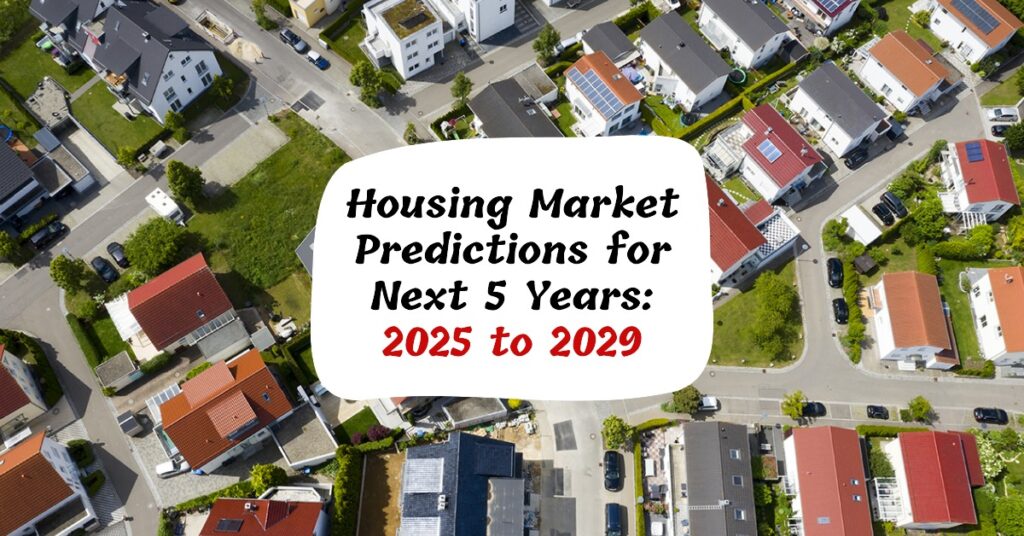U.S. Housing Market Predictions: What to Expect Over the Next Five Years
As we look ahead to the future of the U.S. housing market, industry analysts and experts are cautiously optimistic, yet realistic about the complexities that lie ahead. Here’s a detailed forecast for the next five years, exploring price trends, interest rates, inventory levels, and key factors influencing the market.
Current Landscape and Key Trends
The housing market is characterized by fluctuating conditions influenced by various economic factors. Here’s what to expect in the coming years:
1. Home Prices: Gradual Rise with Caveats
- Slowing Growth: After a period of rapid price increases, home prices are projected to rise at a more moderate pace. While increases of around 1-2% annually are anticipated, the days of steep surges may be waning.
- Regional Variations: Some areas may experience stronger growth due to ongoing demand, but widespread affordability challenges could limit price hikes in less accessible markets.
2. Increasing Supply of Homes
- More Listings: A response to the previous low inventory situation, the supply of homes is expected to increase significantly. With more builders entering the market and current homeowners cashing in on rising prices, buyers will find more options available.
- Underbuilding Challenges: Though the influx of new homes is promising, years of underbuilding have deeply impacted the market, highlighting the need for sustained construction efforts.
3. Interest Rates: A Balancing Act
- Gradual Regulation: Following aggressive Federal Reserve rate hikes to curb inflation, mortgage rates are expected to stabilize around 6%. This offers potential relief for prospective buyers.
- Impact on Demand: Despite slight easing, higher rates may continue to strain affordability, leading many to reconsider their buying options.
4. Market Dynamics: Competition Remains
- Stable Demand: Strong job growth and demographic shifts will maintain competitive conditions in the housing market. Millennials are increasingly entering the home-buying stage, leading to sustained interest in properties.
- Family Purchasing Trends: More buyers may choose to pool resources, forming intergenerational households to navigate rising costs effectively.
What to Anticipate by 2025
Striking a Balance
The year 2025 could see a shift towards a more stable market:
- Home Values: Predictions indicate home values may slightly decline by 1.4% due to growing availability amid potentially languishing sales.
- Wage Growth: An increase in wages and a slight drop in mortgage rates might improve affordability, fostering a more favorable buying environment.
"The next five years hold potential for both challenges and opportunities in the U.S. housing market, driven by evolving economic and demographic trends."
Economic Indicators for 2026 and Beyond
Continued Upward Trajectory
By 2026, factors like pent-up demand and improved housing supply could contribute to a stabilizing market:
- Home Prices: Prices are expected to rise moderately, spurred on by economic growth and favorable borrowing conditions.
- Rising Construction Technologies: Innovations in building practices could expedite construction timelines, enhancing market efficiency.
The Role of Technology
Advancements in technology, such as virtual tours and data analytics, will further enhance the buying experience, making homes more accessible to potential buyers.
Anticipated Changes by 2027
By 2027, urban migration is likely to escalate, leading to increased demand for housing in suburban and rural areas. Remote work trends may further shape buyer preferences, creating additional opportunities in these locales.
Long-Term Considerations: 2028 and 2029
Consistent but Moderate Growth
- Affordability: Potential improvements in affordability, driven by increased inventory and possible reductions in mortgage rates, will continue to attract buyers.
- Price Trends: Gradual price increases of 3-5% annually until 2029 are anticipated as the market stabilizes post-volatile years.
Key Factors to Monitor:
- Government Policies: Legislation affecting homeownership, zoning laws, and tax structures will play pivotal roles in determining the housing landscape.
- Investor Behaviors: Changes in institutional investor interest could impact home prices and availability in different regions.
Conclusion: A Balanced Outlook
While the U.S. housing market is poised for gradual price increases and improved affordability, several market dynamics will prevent it from becoming a straightforward buyer’s market anytime soon. With strong demand buttressed by evolving demographics, both buyers and sellers should remain engaged in monitoring these ongoing changes.
For more insights and updates on housing trends, visit National Association of Realtors and Zillow.
In summary, as we project our gaze into the future, the next five years promise to be a telling period for the U.S. housing market, highlighting the important intersection of economic indicators, societal norms, and shifting buyer preferences.


